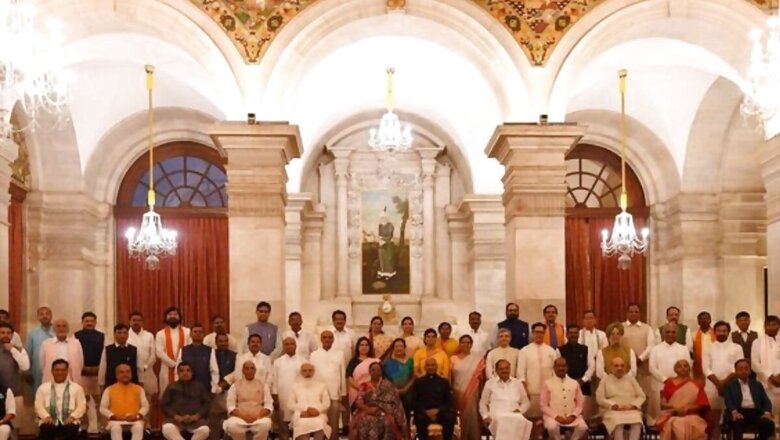
views
The recent cabinet reshuffle by the Narendra Modi government is aimed more at social engineering than being a step towards providing better governance. This social engineering is largely aimed at Bharatiya Janata Party’s (BJP) strategy of electoral gains to consolidate political power in states as well as at the Centre. The careful selection of new ministers, keeping in mind the caste calculations and state representations, is aimed towards electoral mobilisation not merely for the forthcoming Assembly elections, but also for the big 2024 Lok Sabha elections.
Inducting so many ministers in the cabinet from the five states going to polls early next year is a clear indication of the party preparing for the forthcoming Assembly elections. But at the same time, the careful calculation of on-boarding ministers from various social backgrounds, with clear emphasis on Dalits and OBCs, especially the lower OBCs, does indicate that the party is also preparing for the 2024 Lok Sabha elections.
Not that the government does not want to send out the message that commitment to good governance is its priority, and it has done so by putting emphasis on qualification and experience of the newly inducted ministers. In doing so, the government wants to send out the message that these newly inducted ministers would be able to handle their responsibilities. Given a sense of unhappiness among people, the government has tried using this cabinet expansion for putting across the message that Narendra Modi means business and non-performance has no place in Modi’s cabinet. The government has also tried signalling that Prime Minister does care for the allies and values their association with the NDA (National Democratic Alliance).
The Numbers Matter
Although the government tried addressing several issues through this cabinet expansion, the core focus remains the BJP’s effort towards social engineering, more for electoral gains than welfare of people belonging to Scheduled Castes and Other Backward Classes. It is important to note that one of the reasons for the BJP’s big success in 2014 and further consolidation of its vote share from 31 per cent in 2014 to 37 per cent in 2019 was a massive shift among the Dalits and OBCs towards the party. In the 2014 Lok Sabha elections, 24 per cent Dalits voted for the BJP which increased to 33 per cent in 2019. Among the OBCs, 34 per cent voted for the BJP in 2014 which increased to 44 per cent in 2019 Lok Sabha elections. By inducting a large number of ministers from Dalit and OBC communities, the BJP wants to retain its hold over the voters from these two communities, which are numerically strong.
ALSO READ | It’s Mission UP: Narendra Modi Cabinet Expansion Sends Clear Signal before Make or Break Polls
The BJP may have tried social engineering under the garb of good governance. That perhaps explains the emphasis on qualification and experience of the newly inducted ministers. But mere qualification or experience does not guarantee good governance. The ministers who have been dropped were no less qualified. Who could have been more qualified than Dr Harsh Vardhan, a doctor with enormous political experience, but who could not meet the expectations of the Prime Minister and the common people to a large extent, who suffered enormously during the second wave of the pandemic? Not that Ravi Shankar Prasad is not qualified, but still his performance does not seem up to mark as judged by the Prime Minister who heads the cabinet.
So, one can’t really say how the quality of governance might change with this change in the ministry by way of a cabinet reshuffle. While the government defends having so many faces from the OBC and Dalit communities by stating its commitment to Sabka Saath Sabka Vikaas, it may find it difficult to promise better governance only by emphasising the qualification and experience of the newly inducted ministers.
The Rationale for Reshuffle
Promise of better governance can be offered as a rationale for the cabinet reshuffle, but looking at the changes in the ministries and the ministers, one can’t say for sure if performance and fixing responsibility were the criteria for dropping some known faces from the cabinet. It is true that the government’s handling of the second wave of pandemic was questioned and Health Minister Harsh Vardhan and his deputy Ashwini Kumar Choubey have been shown the door to demonstrate government’s commitment to fixing responsibility, but what explains the finance ministry not being touched?
The economic hardships faced by Indians are not unknown to anyone, yet Nirmala Sitharaman continues to remain in charge of the Finance Ministry. So, more than going by the system of reward and punishment as criteria for this reshuffle, other “invisible criteria”, namely the BJP’s electoral consolidation by way of appeasing its existing allies and sending out positive signals to social groups who had voted for the party, seem to be the dominant consideration.
ALSO READ | Cabinet Reshuffle Positions Narendra Modi as Champion of OBCs, Right before Crucial Polls
Through this cabinet reshuffle, the government has also tried to strengthen the BJP’s alliance with allies, namely Janata Dal (United) in Bihar and Apna Dal in Uttar Pradesh. It is important to remember that the JD (U) did not join the government in 2019 on the issue of number of ministerial berths being offered to the party, but agreed to join the cabinet this time although the quota for the party remained unchanged. RCP Singh of JD(U) is the new Minister of Steel. Similarly, Anupriya Singh Patel from the Apna Dal is the new Minister of State in the Commerce and Industry Ministry.
There are some other smaller windfalls for the government in this cabinet expansion. As many young faces have been included in the new cabinet, the government could assert that this is the youngest cabinet, so far. By inducting seven new women ministers, the government also managed to send out a message that this council of ministers has better female representation as compared to previous regimes.
All in all, the government tried to achieve several targets by just one cabinet reshuffle.
Read all the Latest News, Breaking News and Coronavirus News here.



















Comments
0 comment